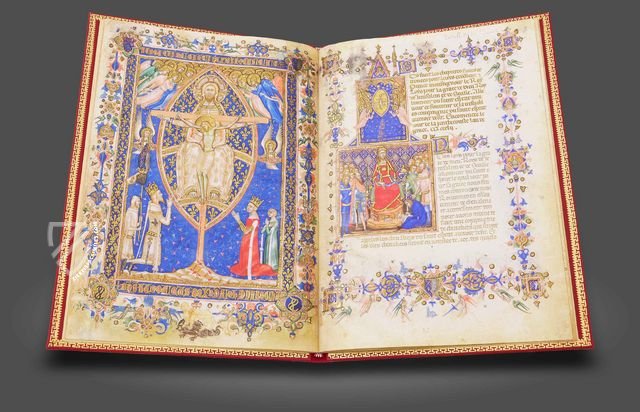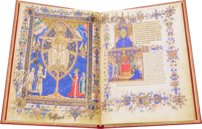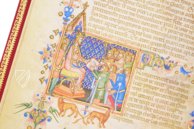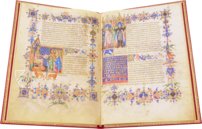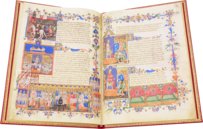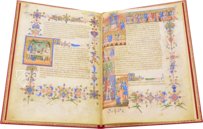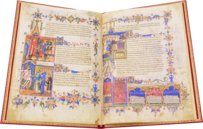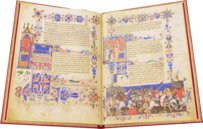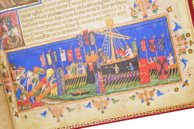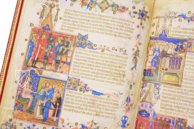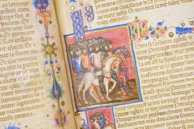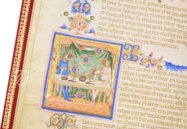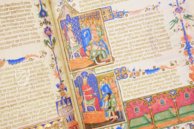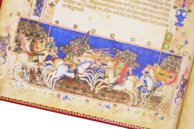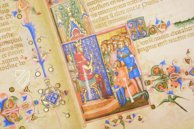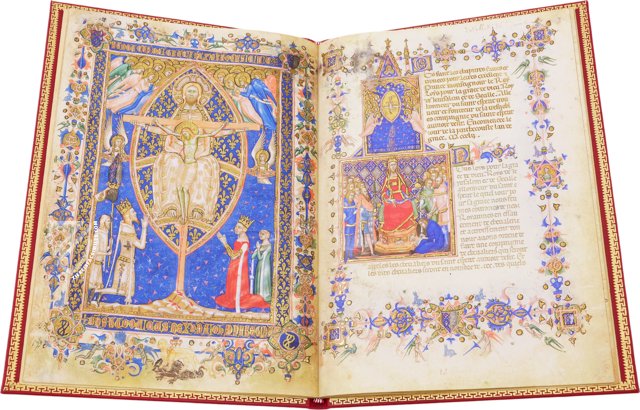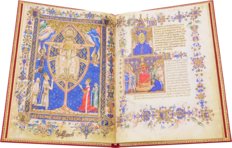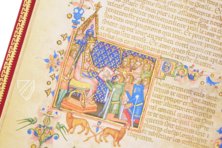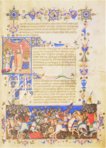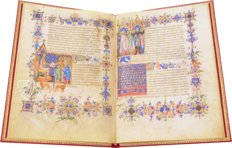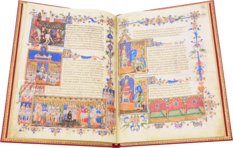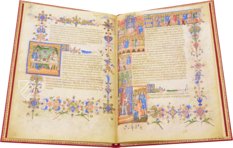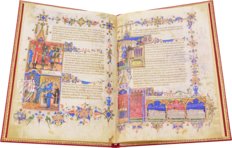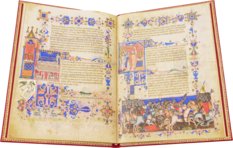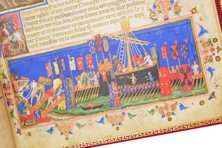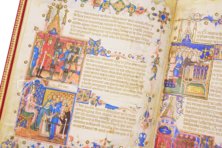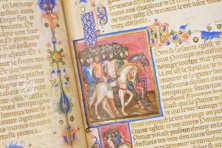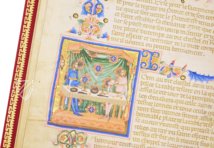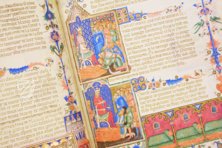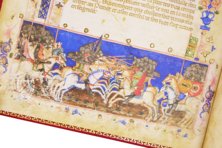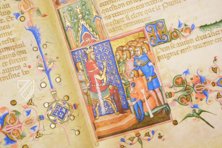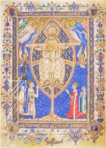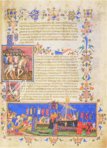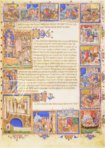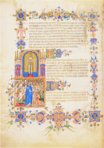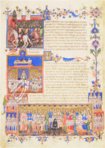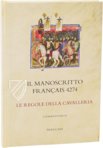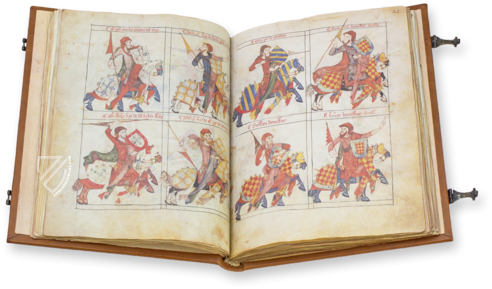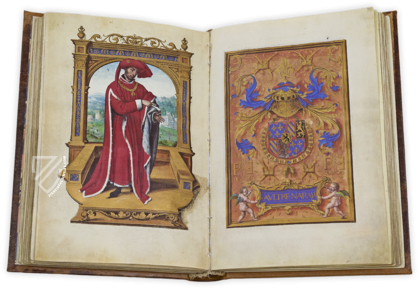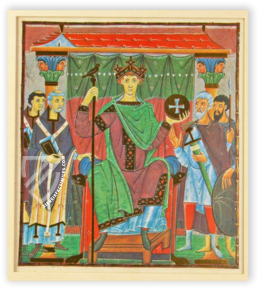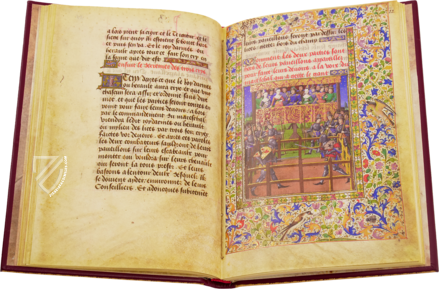Statutes of the Ordre de Saint-Esprit au Droit Désir
(3,000€ - 7,000€)
Founded on Pentecost in 1352, the Ordre du Nœud or “Order of the Knot” was a knightly order established by King Louis I of Naples (1320–1362) to commemorate his own coronation. This beautiful Trecento manuscript from the Bibliothèque nationale de France contains the fascinating statutes of the medieval order, providing a fascinating insight into its inner workings. Cristoforo Orimina illuminated all of the pages with wonderful miniatures, which sparkle in rich blue and shiny gold leaf and depict, among other things, important ceremonies and the valiant deeds of the order's knights. In addition, almost every page is surrounded by an elaborate border. This opulence, combined with its remarkable content, is possibly one of the reasons why the Gothic manuscript later came into the possession of the French king Henry III (1551–1589).
Statutes of the Ordre de Saint-Esprit au Droit Désir
Chivalric orders were all the rage in the Late Middle Ages and various dynasties created their own orders, some of which still exist today like the Order of the Garter, founded in 1348 by King Edward III of England (1312-77). Doubtless inspired by this and other chivalric orders, King Louis I of Naples (1320-62), created the Ordre du Nœud or “Order of the Knot” in 1352. Although the order itself was not long lived, the manuscript containing the Statutes of the Ordre du Nœud has endured as a masterfully illuminated witness to the rituals and heroic deeds associated with any knightly order. 17 colorful miniatures with gold leaf reminiscent of Giotto (ca. 1267-1337), including a full-page Crucifixion scene, adorn the text along with gorgeous floral tendril borders filled with vases, animals, and birds.
A Neapolitan Chivalric Order
On Pentecost in the year 1352, Louis of Taranto was crowned King Louis I of Naples alongside his wife, Queen Joanna I (1325-82). To mark the occasion, he founded a chivalrous order – the Ordre du Nœud. Founding a chivalric order served to legitimize the King as a Christian ruler and defender of the Church, provide a core of 300 elite knights for his armies, and create a trusted group of advisors. The members of the order were chosen and dubbed solely by the King, who also served as the Order Master, and wore white habits to symbolize the faith and honor of the knights, who were also expected to fast on Fridays. A knot of purple and gold-red silk threads, which was fastened to the knight's chest or arm after the oath of allegiance, was their only decoration.
Images of Chivalry
According to the Statutes, certain acts of bravery could allow a knight to untie their knot. The untied knot was taken by the knight as a pilgrim to Jerusalem and placed at the Holy Sepulcher with the inscription of his name in a prominent place. Only then could the knot be tied again, with a tongue of fire on it, crowned with the knight's name under the new motto: a pleut à Dieu or “God has willed it”. However, this custom and other chivalric traditions were never fully realized because the order did not last long after the death of its founder in 1362. The Statutes of the Ordre du Nœud has nonetheless survived as a beautifully illuminated testimonial to chivalric orders in the Late Middle Ages. Scenes depicting various rituals and ceremonies offer a precious glimpse the inner workings of this order, which may be why the manuscript was once owned by King Henry III of France (1551-89).
Echoes of Giotto
Cristoforo Orimina was a 14th century Italian illuminator active at the royal court of Naples and was descended from a patrician Neapolitan family. Regarded as one of the great masters of the Trecento, the miniatures Orimina created for this manuscript are strongly reminiscent of the great Giotto. Furthermore, Orimina reinterprets Giotto according to the stylistic features of Pietro Cavallini (1259 – 1330), giving shape to a sumptuous and elegant visual language. From the plasticity of the figures to the spatiality of the scenes containing them, this is a unique and intact specimen that is exemplary of the art of medieval miniatures.
Codicology
- Alternative Titles
- Le Regole della Cavalleria. Statuti dell'Ordine del Santo Spirito dal Giusto Desiderio
Ordre du S.-Esprit au Droit-Désir
Die Regeln der Ritterlichkeit. Statuten des Ordre du Nœud
The Rules of Chivalry. Statutes of the Ordre du Nœud
Institution de l'ordre du Saint Esprit par le roy de Sicile et de Hierusalem
Statuts de l'ordre du Saint-Esprit au droit désir
Statutes of the Order of the Knot
Le regole della cavalleria - Type
- Manuscript on paper
- Size / Format
- 22 pages / 35.6 × 25.8 cm
- Origin
- Italy
- Date
- 1352–1354
- Epochs
- Style
- Language
- Script
- Gothic
- Illustrations
- 17 miniatures including one full-page, decorative borders
- Content
- Rules of the Ordre du Noeud (or Order of Saint Esprit au Droit Désir), founded by Louis of Taranto, lord of Taranto, in 1352
- Patron
- Louis of Taranto
- Artist / School
- Cristoforo Orimina
- Previous Owners
- Henry III of France
Royal Library
François Roger de Gaignières
Statutes of the Ordre de Saint-Esprit au Droit Désir
Investiture of Three New Members of the Order of the Knot
All military religious orders had their own initiation ceremonies including various rites, rituals, and regalia e.g., the figures depicted here have pieces of cloth attached to their upper arms and wear golden knots on the breasts of their tunics semy. These three initiates stand before the King and his sword-bearer fully-armed; the king personally girds them with their new swords, standing beneath a dove wreathed in rays of light — the symbol of the Holy Spirit and thus of divine blessing, but also of the royal order.
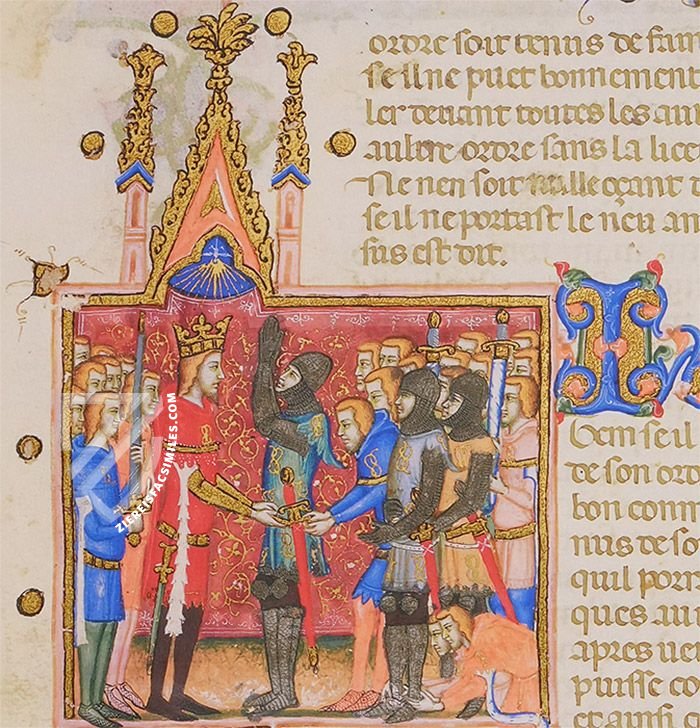
Statutes of the Ordre de Saint-Esprit au Droit Désir
The Royal Family before the Throne of Mercy
The creation of the Order of the Knot coincided with the coronation of Prince Louis of Taranto and Joanna of Naples as the King and Queen of Naples. Two Latin inscriptions appear in the blue and gold fleur-de-lys patterned frame: top – “Louis, by the Grace of God, King of Jerusalem and Sicily”, bottom – “Lord Louis, King, Lady Johanna, Queen”. The King’s French motto is carried by two angels with banderoles: “if God wills it”.
Louis kneels on the left accompanied by a squire carrying a crowned helmet with wings, one with fleurs-de-lys, as well as a golden knot. Joanna, who ruled in her own right before their marriage and after her husband’s death, kneels on the right with their daughter Françoise, who tragically died on their coronation day. They are all at the feet of a magnificent Throne of Mercy: inside a mandorla and surrounded by a host of angels, God the Father holds the crucified Christ with the Holy Spirit represented by a dove connecting them.
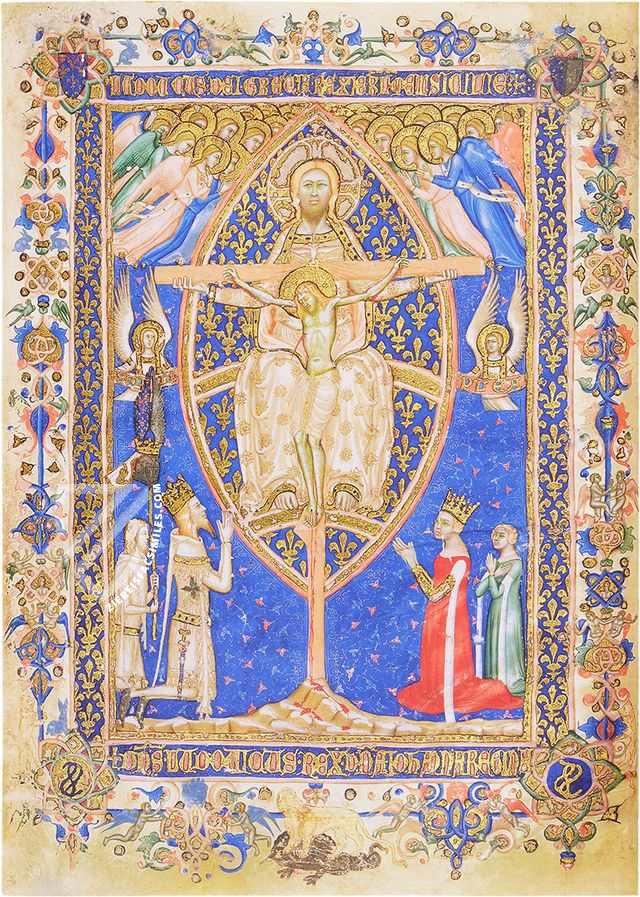
#1 Le Regole della Cavalleria. Statuti dell'Ordine del Santo Spirito dal Giusto Desiderio
Language: Italian
(3,000€ - 7,000€)
- Treatises / Secular Books
- Apocalypses / Beatus
- Astronomy / Astrology
- Bestiaries
- Bibles / Gospels
- Chronicles / History / Law
- Geography / Maps
- Saints' Lives
- Islam / Oriental
- Judaism / Hebrew
- Single Leaf Collections
- Leonardo da Vinci
- Literature / Poetry
- Liturgical Manuscripts
- Medicine / Botany / Alchemy
- Music
- Mythology / Prophecies
- Psalters
- Other Religious Books
- Games / Hunting
- Private Devotion Books
- Other Genres
- Afghanistan
- Armenia
- Austria
- Belgium
- Belize
- Bosnia and Herzegovina
- China
- Colombia
- Costa Rica
- Croatia
- Cyprus
- Czech Republic
- Denmark
- Egypt
- El Salvador
- Ethiopia
- France
- Germany
- Greece
- Guatemala
- Honduras
- Hungary
- India
- Iran
- Iraq
- Israel
- Italy
- Japan
- Jordan
- Kazakhstan
- Kyrgyzstan
- Lebanon
- Liechtenstein
- Luxembourg
- Mexico
- Morocco
- Netherlands
- Palestine
- Panama
- Peru
- Poland
- Portugal
- Romania
- Russia
- Serbia
- Spain
- Sri Lanka
- Sweden
- Switzerland
- Syria
- Tajikistan
- Turkey
- Turkmenistan
- Ukraine
- United Kingdom
- United States
- Uzbekistan
- Vatican City
- A. Oosthoek, van Holkema & Warendorf
- Aboca Museum
- Ajuntament de Valencia
- Akademie Verlag
- Akademische Druck- u. Verlagsanstalt (ADEVA)
- Aldo Ausilio Editore - Bottega d’Erasmo
- Alecto Historical Editions
- Alkuin Verlag
- Almqvist & Wiksell
- Amilcare Pizzi
- Andreas & Andreas Verlagsbuchhandlung
- Archa 90
- Archiv Verlag
- Archivi Edizioni
- Arnold Verlag
- ARS
- Ars Magna
- ArtCodex
- AyN Ediciones
- Azimuth Editions
- Badenia Verlag
- Bärenreiter-Verlag
- Belser Verlag
- Belser Verlag / WK Wertkontor
- Benziger Verlag
- Bernardinum Wydawnictwo
- BiblioGemma
- Biblioteca Apostolica Vaticana (Vaticanstadt, Vaticanstadt)
- Bibliotheca Palatina Faksimile Verlag
- Bibliotheca Rara
- Boydell & Brewer
- Bramante Edizioni
- Bredius Genootschap
- Brepols Publishers
- British Library
- C. Weckesser
- Caixa Catalunya
- Canesi
- CAPSA, Ars Scriptoria
- Caratzas Brothers, Publishers
- Carus Verlag
- Casamassima Libri
- Centrum Cartographie Verlag GmbH
- Chavane Verlag
- Christian Brandstätter Verlag
- Circulo Cientifico
- Club Bibliófilo Versol
- Club du Livre
- CM Editores
- Collegium Graphicum
- Collezione Apocrifa Da Vinci
- Comissão Nacional para as Comemorações dos Descobrimentos Portugueses
- Coron Verlag
- Corvina
- CTHS
- D. S. Brewer
- Damon
- De Agostini/UTET
- De Nederlandsche Boekhandel
- De Schutter
- Deuschle & Stemmle
- Deutscher Verlag für Kunstwissenschaft
- DIAMM
- Droz
- E. Schreiber Graphische Kunstanstalten
- Ediciones Boreal
- Ediciones Grial
- Ediclube
- Edições Inapa
- Edilan
- Editalia
- Edition Deuschle
- Edition Georg Popp
- Edition Leipzig
- Edition Libri Illustri
- Editiones Reales Sitios S. L.
- Éditions de l'Oiseau Lyre
- Editions Medicina Rara
- Editorial Casariego
- Editorial Mintzoa
- Editrice Antenore
- Editrice Velar
- Edizioni Edison
- Egeria, S.L.
- Eikon Editores
- Electa
- Emery Walker Limited
- Enciclopèdia Catalana
- Eos-Verlag
- Ephesus Publishing
- Ernst Battenberg
- Eugrammia Press
- Extraordinary Editions
- Fackelverlag
- Facsimila Art & Edition
- Facsimile Editions Ltd.
- Facsimilia Art & Edition Ebert KG
- Faksimile Verlag
- Feuermann Verlag
- Folger Shakespeare Library
- Franco Cosimo Panini Editore
- Friedrich Wittig Verlag
- Fundación Hullera Vasco-Leonesa
- G. Braziller
- Gabriele Mazzotta Editore
- Gebr. Mann Verlag
- Gesellschaft für graphische Industrie
- Getty Research Institute
- Giovanni Domenico de Rossi
- Giunti Editore
- Graffiti
- Grafica European Center of Fine Arts
- Guido Pressler
- Guillermo Blazquez
- Gustav Kiepenheuer
- H. N. Abrams
- Harrassowitz
- Harvard University Press
- Helikon
- Hendrickson Publishers
- Henning Oppermann
- Herder Verlag
- Hes & De Graaf Publishers
- Hoepli
- Holbein-Verlag
- Houghton Library
- Hugo Schmidt Verlag
- Idion Verlag
- Il Bulino, edizioni d'arte
- ILte
- Imago
- Insel Verlag
- Insel-Verlag Anton Kippenberger
- Instituto de Estudios Altoaragoneses
- Instituto Nacional de Antropología e Historia
- Introligatornia Budnik Jerzy
- Istituto dell'Enciclopedia Italiana - Treccani
- Istituto Ellenico di Studi Bizantini e Postbizantini
- Istituto Geografico De Agostini
- Istituto Poligrafico e Zecca dello Stato
- Italarte Art Establishments
- Jan Thorbecke Verlag
- Johnson Reprint Corporation
- Josef Stocker
- Josef Stocker-Schmid
- Jugoslavija
- Karl W. Hiersemann
- Kasper Straube
- Kaydeda Ediciones
- Kindler Verlag / Coron Verlag
- Kodansha International Ltd.
- Konrad Kölbl Verlag
- Kurt Wolff Verlag
- La Liberia dello Stato
- La Linea Editrice
- La Meta Editore
- Lambert Schneider
- Landeskreditbank Baden-Württemberg
- Leo S. Olschki
- Les Incunables
- Liber Artis
- Library of Congress
- Libreria Musicale Italiana
- Lichtdruck
- Lito Immagine Editore
- Lumen Artis
- Lund Humphries
- M. Moleiro Editor
- Maison des Sciences de l'homme et de la société de Poitiers
- Manuscriptum
- Martinus Nijhoff
- Maruzen-Yushodo Co. Ltd.
- MASA
- Massada Publishers
- McGraw-Hill
- Metropolitan Museum of Art
- Militos
- Millennium Liber
- Müller & Schindler
- Nahar - Stavit
- Nahar and Steimatzky
- National Library of Wales
- Neri Pozza
- Nova Charta
- Oceanum Verlag
- Odeon
- Orbis Mediaevalis
- Orbis Pictus
- Österreichische Staatsdruckerei
- Oxford University Press
- Pageant Books
- Parzellers Buchverlag
- Patrimonio Ediciones
- Pattloch Verlag
- PIAF
- Pieper Verlag
- Plon-Nourrit et cie
- Poligrafiche Bolis
- Presses Universitaires de Strasbourg
- Prestel Verlag
- Princeton University Press
- Prisma Verlag
- Priuli & Verlucca, editori
- Pro Sport Verlag
- Propyläen Verlag
- Pytheas Books
- Quaternio Verlag Luzern
- Reales Sitios
- Recht-Verlag
- Reichert Verlag
- Reichsdruckerei
- Reprint Verlag
- Riehn & Reusch
- Roberto Vattori Editore
- Rosenkilde and Bagger
- Roxburghe Club
- Salerno Editrice
- Saltellus Press
- Sandoz
- Sarajevo Svjetlost
- Schöck ArtPrint Kft.
- Schulsinger Brothers
- Scolar Press
- Scrinium
- Scripta Maneant
- Scriptorium
- Shazar
- Siloé, arte y bibliofilia
- SISMEL - Edizioni del Galluzzo
- Sociedad Mexicana de Antropología
- Société des Bibliophiles & Iconophiles de Belgique
- Soncin Publishing
- Sorli Ediciones
- Stainer and Bell
- Studer
- Styria Verlag
- Sumptibus Pragopress
- Szegedi Tudomànyegyetem
- Taberna Libraria
- Tarshish Books
- Taschen
- Tempus Libri
- Testimonio Compañía Editorial
- Thames and Hudson
- The Clear Vue Publishing Partnership Limited
- The Facsimile Codex
- The Folio Society
- The Marquess of Normanby
- The Richard III and Yorkist History Trust
- Tip.Le.Co
- TouchArt
- TREC Publishing House
- TRI Publishing Co.
- Trident Editore
- Tuliba Collection
- Typis Regiae Officinae Polygraphicae
- Union Verlag Berlin
- Universidad de Granada
- University of California Press
- University of Chicago Press
- Urs Graf
- Vallecchi
- Van Wijnen
- VCH, Acta Humaniora
- VDI Verlag
- VEB Deutscher Verlag für Musik
- Verlag Anton Pustet / Andreas Verlag
- Verlag Bibliophile Drucke Josef Stocker
- Verlag der Münchner Drucke
- Verlag für Regionalgeschichte
- Verlag Styria
- Vicent Garcia Editores
- W. Turnowski Ltd.
- W. Turnowsky
- Waanders Printers
- Wiener Mechitharisten-Congregation (Wien, Österreich)
- Wissenschaftliche Buchgesellschaft
- Wissenschaftliche Verlagsgesellschaft
- Wydawnictwo Dolnoslaskie
- Xuntanza Editorial
- Zakład Narodowy
- Zollikofer AG

